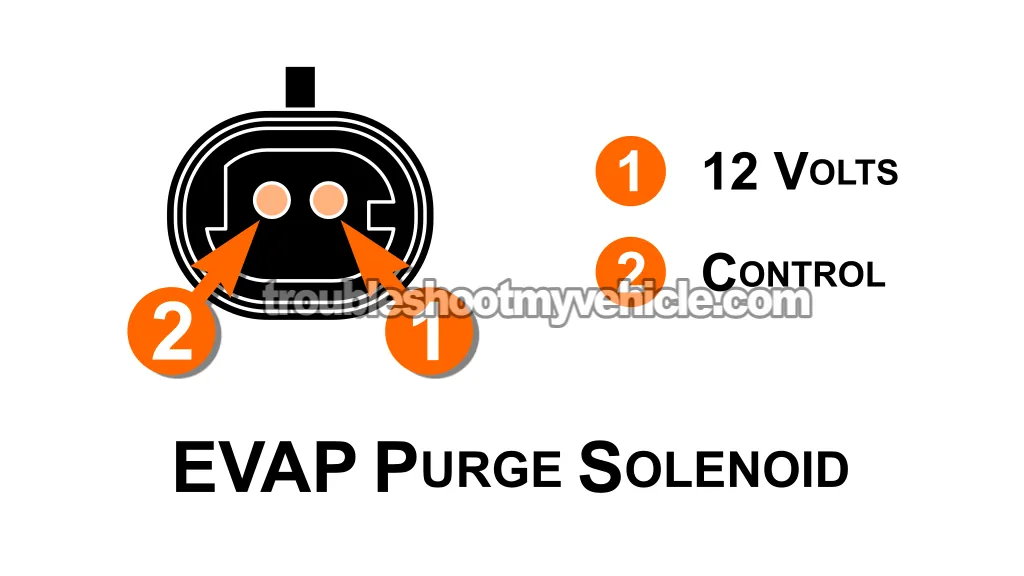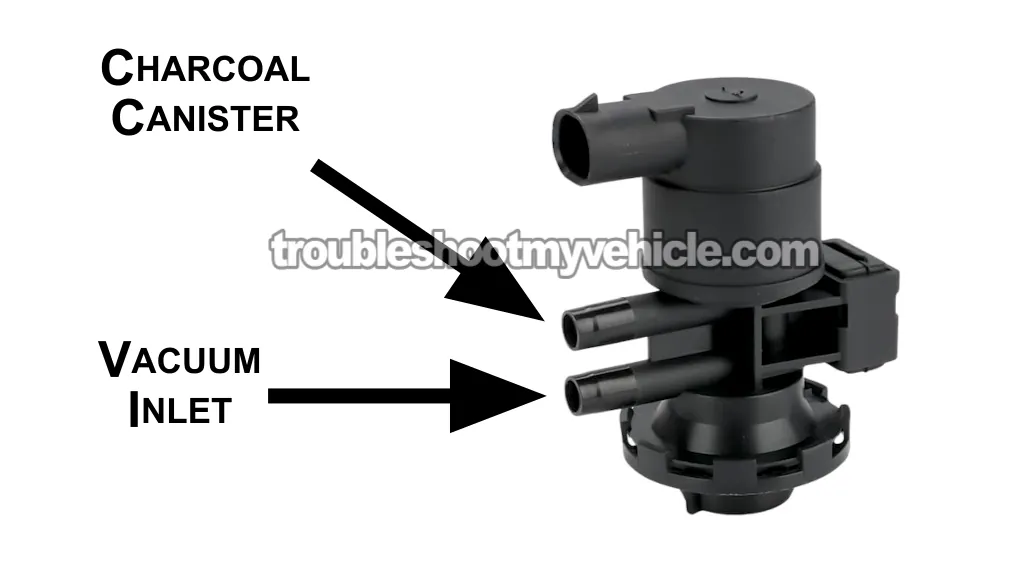
In this tutorial, I'm going to show you how to test the EVAP purge solenoid on your 1996-1998 3.3L V6 Dodge Caravan, Grand Caravan, Voyager, or Grand Voyager —using a simple bench test that doesn't require a scan tool.
You'll also learn what this solenoid does, how it fails, and what symptoms to watch out for —including the common P0441 and P0443 trouble codes.
It's an easy test that can save you from replacing parts you don't need —and you can do it right in your own garage. Let's get started!
Contents of this tutorial:
- What Does The EVAP Purge Solenoid Do.
- Common Ways The EVAP Purge Solenoid Fails.
- Symptoms Of A Bad EVAP Purge Solenoid.
- Check The Hoses (Don't Skip This Step).
- How To Test The EVAP Purge Solenoid (Bench Test —No Scan Tool Needed).
- The Solenoid Checks Out —But P0441 Or P0443 Won't Go Away.
- More 3.3L V6 Chrysler, Dodge, And Plymouth Minivan Tutorials.
APPLIES TO: This tutorial applies to the following vehicles:
- 3.3L V6 Chrysler Town & Country: Late 1996, 1997, early 1998.
- 3.3L V6 Dodge Caravan: Late 1996, 1997, early 1998.
- 3.3L V6 Dodge Grand Caravan: Late 1996, 1997, early 1998.
- 3.3L V6 Plymouth Voyager: Late 1996, 1997, early 1998.
- 3.3L V6 Plymouth Grand Voyager: Late 1996, 1997, early 1998.
EVAP SYSTEM WIRING DIAGRAM:
OTHER EVAP PURGE SOLENOID TUTORIALS:
- EVAP Purge Solenoid Tests -P0441, P0443 (1998-2000 3.3L V6 Chrysler, Dodge, And Plymouth Minivan).
- EVAP Purge Solenoid Tests -P0441, P0443 (2001-2007 3.3L V6 Chrysler, Dodge, And Plymouth Minivan).
What Does The EVAP Purge Solenoid Do
On your 1996-1998 3.3L V6 Dodge Caravan (Grand Caravan, Voyager, and Grand Voyager) the EVAP purge solenoid is part of the EVAP Emissions system that helps keep fuel vapors from escaping into the air.
At its core, the EVAP purge solenoid is just an electronic valve that opens or closes to let vacuum pull fuel vapors from the charcoal canister into the engine.
Here's the process broken down:
- The gasoline in the tank starts creating fuel vapors.
- These fuel vapors get channeled and stored in a charcoal canister.
- The EVAP purge solenoid is connected between the intake manifold and the charcoal canister.
- Its inlet port connects to the charcoal canister via a hose.
- Its outlet port connects to the intake manifold via a hose.
- The PCM (Powertrain Control Module) commands it to open at just the right time —usually when the engine's warmed up and running.
- When the solenoid opens, engine vacuum draws the vapors into the throttle body (and into the intake manifold).
In short, the purge solenoid controls when those vapors get pulled into the engine and burned —instead of venting out into the atmosphere.
If the purge solenoid sticks open, sticks closed, or stops responding, the PCM will usually set an EVAP system fault code —like P0441 or P0443.
Common Ways The EVAP Purge Solenoid Fails
Over the years, I've seen these purge solenoids fail in a few common ways —especially on these older 3.3L Dodge Caravan engines.
Here are the most typical failure points:
-
Valve sticking (mechanical failure):
Inside the solenoid, there's a small valve that opens and closes. Over time, the valve can stick —either in the open or closed position— because of dirt, varnish buildup, or just plain old age. When this happens, the PCM usually sets a P0441 (Incorrect Purge Flow) trouble code. -
Electrical failure (coil or wiring):
The solenoid has a small coil of wire inside. If that coil burns out or the wiring to the solenoid gets damaged (broken connectors are a common issue), you'll likely see a P0443 (Purge Solenoid Circuit) code pop up. - Vacuum line or rubber connector leaks:
The vacuum supply and the fuel vapor line to the purge solenoid use plastic lines with short rubber connectors at each end. Over time, these rubber connectors can dry out and leak —or the plastic lines themselves can develop cracks. Even with a good solenoid, this type of leak will still cause a P0441 to set.
Symptoms Of A Bad EVAP Purge Solenoid
When the EVAP purge solenoid goes bad on your 3.3L Dodge Caravan (or Grand Caravan, Voyager, Grand Voyager), you may or may not notice any obvious symptoms. In fact, a lot of the time, the only clue is the Check Engine Light coming on.
The most common codes you'll see are:
- P0441: EVAP Purge Flow Fault.
- P0443: Purge Solenoid Circuit Fault.
Occasionally, you might also notice a few drivability issues like:
- A slightly rough idle.
- Hard starting right after filling up the gas tank.
But not always —many folks drive around for months with a bad purge solenoid and never feel anything different, other than that light on the dash.
That's why it's worth testing the solenoid when these codes show up —it's a quick and simple check you can do yourself (see below).
Check The Hoses (Don't Skip This Step)
Before you pull the purge solenoid out for testing, there's one simple thing you should do first —check the two small hoses that connect to it.
The EVAP purge solenoid has two ports —one hose comes from the fuel vapor canister, and the other goes to the intake manifold. Both hoses need to be in good condition and fit snugly on the solenoid ports.
It's important to inspect them thoroughly, because a perfectly good solenoid can still cause the PCM to set a P0441 code if there's a cracked or loose-fitting hose.
Here's what to check:
- Look for dry rot —old hoses can crack or split with age.
- Check for loose fit —hoses should grip the ports tightly. If they slide off too easily, replace them.
- Look for pinholes or soft spots —squeeze the hoses and inspect them closely.
Even if the solenoid itself is fine, a leaking or loose hose will still cause problems —and can trigger that P0441 code. So take a minute and check them carefully— it's a quick step that can save you time.
How To Test The EVAP Purge Solenoid (Bench Test —No Scan Tool Needed)
Testing the EVAP purge solenoid on your 3.3L Dodge Caravan is quick and easy. You don't need a scan tool, smoke machine, or any fancy gear. Just a basic 12 Volt power source (like your minivan's battery or even a jump pack) and a couple of jumper wires.
First, remove the purge solenoid from the vehicle. It's usually mounted near the passenger-side strut tower on these models —with one electrical connector and two small vacuum hoses attached. Label the hoses if needed so you don't mix them up during reinstallation.
PART 1: Electrical test:
- Remove the EVAP purge solenoid off its mounting bracket (in the engine compartment).
- Locate the two electrical pins on the solenoid.
- Connect one jumper wire to terminal 1 and the other end to your minivan's positive (+) battery terminal.
- NOTE: Use jumper wires with insulated alligator clips, so the clips don't short together.
- 10 Pc. And 5 Color Insulated Alligator Clips (at: amazon.com).
- Connect the other jumper wire to terminal 2 and the other end to the battery negative (-) terminal.
- When you make the last connection to the negative (-) battery terminal, you should hear a solid "click" —that's the internal valve opening.
- When you remove the Ground connection, you should hear another click —valve closing.
PART 2: Air flow check:
- Connect a piece of vacuum hose to the outlet port of the solenoid.
- Energize (apply power to) the solenoid.
- Blow air through the hose into the solenoid:
- It should flow freely when powered.
- De-energize (remove power from) the solenoid:
- It should block airflow —no air should pass through.
If it doesn't click, or if air flows through it when it shouldn't, the solenoid is bad and needs to be replaced to correct the EVAP system fault —and clear those P0441 or P0443 trouble codes.
Here are the replacements I recommend:
- Standard Motor Products CP415 Solenoid (at: amazon.com)
- Used as an EGR solenoid and EVAP purge valve solenoid.
- Dorman 911-213 Vapor Canister Purge Valve
The EVAP Purge Solenoid Checks Out —But P0441 Or P0443 Won't Go Away
You've tested the purge solenoid and it passed. Airflow is correct, clicking sound is good, hoses are solid —yet your P0441 or P0443 keeps coming back?
Here's where to look next:
- Hose orientation matters: It's surprisingly easy to swap the inlet and outlet hoses during reinstallation.
- Verify engine vacuum at the solenoid: With the engine running, check for strong vacuum at the hose leading to the VAC port of the purge solenoid. If vacuum is weak or missing, the line may be restricted —or the intake port could be blocked.
- Electrical checks: On these early models, wiring issues are common —look closely for corroded pins on the solenoid and its connector, cracked/damaged connector, or damaged wires coming out of the connector. These faults can cause an intermittent P0443.
- Inspect the line going to the charcoal canister: Follow the plastic line from the purge solenoid all the way to the canister:
- Make sure the line is fully seated and making a tight seal on the canister port.
- Check the entire length for cracks or any kind of damage.
- Disconnect both ends of the line and blow air through it to confirm there are no obstructions. The charcoal canister can break down internally (it happens) and send charcoal into the line —clogging it and blocking vapor flow.
- Inspect the charcoal canister: Don't forget to check the charcoal canister itself for cracks or other damage.
After confirming these basics things, if the code still persists, it's time to move deeper into the EVAP system —other components (like the leak detection pump) could be at fault.
More 3.3L V6 Chrysler, Dodge, And Plymouth Minivan Tutorials
You can find a complete list of tutorials in this index:
Here's a sample of the tutorials you'll find in the index:
- How To Test The MAP Sensor (2001-2004 3.3L V6 Chrysler And Dodge Minivan).
- How To Test The Alternator (2001-2007 3.3L Chrysler).
- How To Test Engine Compression (1991-2010 3.3L V6 Chrysler, Dodge, Plymouth Minivan).
- How To Check For Vacuum Leaks: Carb Cleaner Spray (1991-2010 3.3L V6 Chrysler, Dodge, And Plymouth Minivan).

If this info saved the day, buy me a beer!



